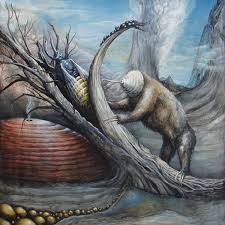The history of tape and electronic music has long, deep roots in the fertile soil of San Francisco’s Bay Area, from which Thomas Carnacki and Vulcanus 68 are relatively new fruits. Its abundance of open-minded academic institutions has cultivated a network of experimental greenhouses, full of faculties, college radio stations and performance venues that have been planting avant-garde audio philosophies in beds of developing technologies for decades. Indeed, Mills College alone boasts a long list of key figures from the history of experimental electronic music including John Cage, Terry Riley, Pauline Oliveros, Morton Subotnik, Robert Ashley, Steve Reich and Laurie Anderson who all studied or taught (or did both) at the institution.
In today’s sea breeze, drifting into the Bay from the Pacific infused with decades of freely creative sonic play, Thomas Carnacki and Vulcanus 68 have formed this split release inspired by "the hallowed masters of tape and electronic music," as its sleeve-notes proclaim. But each has a markedly different take on its use of tape and tones, while both extend their homage overseas to Europe’s equally rich seams of electronic experimentation.
Vulcanus 68’s side provides perhaps the most nostalgic rendering of spliced and collaged tape techniques. Formed about ten years ago by Jared Blum and Dominic Cramp, the duo’s occasional releases all involve samples and synths that reflect yesteryear’s hands-on experimentations, now overshadowed by today’s point-and-click desktop dominance. While their last album, 2011’s Contours And Colours, posed a more "classical" mood of synth symphonies suitable for science fiction themes, the two pieces offered on this latest release return to the rougher rudiments of their earlier work explicitly influenced by musique concrète. This is particularly the case with the short piece ‘Azra’ whose four minutes evoke 1950s laboratories whose stale air is spiced and sliced with unstable, echoic tones, voice fragments and varispeed effects. The longer piece, ‘Arcano XV’, pulls off a more psychedelic atmosphere culled from live sessions between 2008 and 2010. Kicking off with a parade of deliriously bending noises, a low, suspended moaning emerges before a deliciously crackling fire as it is gradually invaded by foreign, radiophonic stabs and suspense trills.
On the other side, Thomas Carnacki’s 20 minute contribution seems more contemporary and more idiosyncratic, ploughing its own field rather than nodding to its ancestors buried beneath. Although, that’s not to say the field is an isolated one – the nearest neighbour to Carnacki’s personal soundworld being the surrealism of Nurse With Wound, with whom the collective’s founder, Greg Scharpen, has played before, as well as being a long-term friend and collaborator with the Nurse’s own West Coast correspondent, Matt Waldron (AKA irr. app. (ext.)) who provided the Lovecraftian cover for this release. Like much of Nurse With Wound’s output, the longform piece elusively-titled ‘Elegant Things, Distressing Things, Things Not Worth Doing’, is based around some exquisitely captured creaks and splashes interwoven with almost-musical matter. This combination of recognisable sound elements (footsteps in water, seagull cries) with eerie, unidentifiable others (all manner of sinister electronic shards and lengthy, portentous scrapes) casts a narrative of sorts in the mind on initial inspection – an exploration of a haunted shipwreck, perhaps. But with subsequent listens avoiding the urge to identify the significance of the sounds – which apparently includes a coffee grinder, a jar of marbles and "some rocks" – we get a beautifully engaging and evolving series of crafted textures and tones to orbit our ears and enter our unconscious. The result is an evocative dimension akin to Burroughs’ interzone, whose definition works equally well in describing Carnacki’s soundworld: "where three-dimensional fact merges into dream, and dreams erupt into the real world…".
In view of this oneiric dimension it’s unsurprising to learn that Scharpen is an award-winning sound designer, dreaming up soundtracks, both foley and score, for theatre and dance productions over the past twenty years or so. With an open-minded attitude that seeks sounds from anywhere (he has been seen to perform with a mic’d up tray of living scorpions, even) he blends the forensic skill of an editor with the wild creativity of a Dadist performance artist to form compelling, wordless dramas that offer respite from the clumsy granularity of a talking brain, channeling a more defined yet non-verbal experience of waking dream states.


